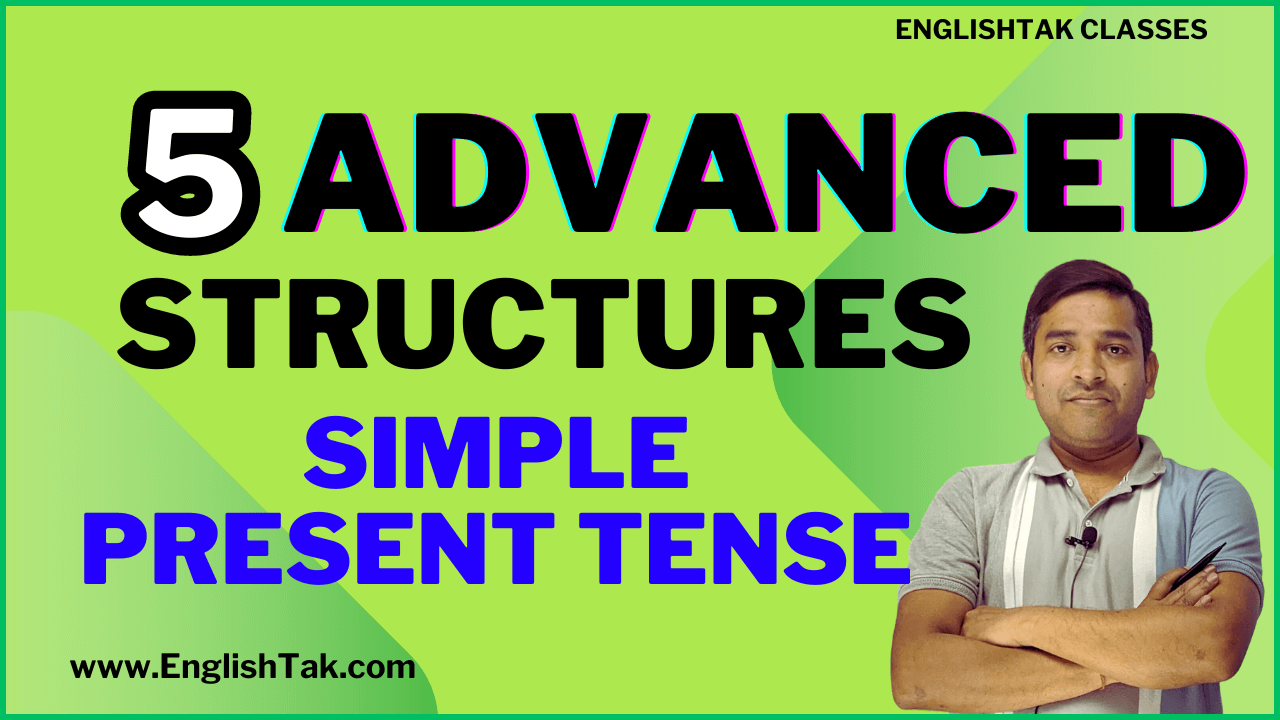![]()
Advanced Structures of Simple Present Tense
Table of Contents
Advanced Structures of Simple Present Tense – Did you think you’ve mastered the simple present tense of English? think again! Although it may seem like a straightforward verb form used for everyday tasks, the simple present has hidden depths waiting to be discovered. In this blog post, we’ll delve deeper into the advanced structures of this seemingly basic tense, revealing its versatility and power in expressing various ideas. Get ready to expand your understanding and take your English fluency to the next level!
Advanced Structures of Simple Present Tense
1. Sub + V1 + /s/es + Obj
Examples
1. She drinks coffee every morning. (वह हर सुबह कॉफी पीती है।)
2. We play cricket on Sundays. (हम रविवार को क्रिकेट खेलते हैं।)
3. The teacher teaches English. (शिक्षक अंग्रेजी पढ़ाता है।)
4. He reads a book every night. (वह हर रात एक किताब पढ़ता है।)
5. They cook dinner together. (वे साथ में खाना बनाते हैं।)
6. My brother writes poems. (मेरा भाई कविताएँ लिखता है।)
7. The sun shines brightly. (सूर्य चमकता है।) (Note: Hindi doesn’t need a separate subject for natural phenomena)
8. Birds sing beautiful songs. (पक्षी सुंदर गीत गाते हैं।)
9. I water the plants every day. (मैं हर रोज पौधों को पानी देता हूँ।)
10. She cleans the house regularly. (वह नियमित रूप से घर साफ करती है।)
2. Sub + Want / Wants + to + V1 + Obj
Examples
1. I want to eat pizza. (मैं पिज्जा खाना चाहता हूँ।)
2. She wants to learn Hindi. (वह हिंदी सीखना चाहती है।)
3. We want to travel to Europe. (हम यूरोप घूमना चाहते हैं।)
4. They want to watch a movie. (वे फिल्म देखना चाहते हैं।)
5. My brother wants to buy a new car. (मेरा भाई नई कार खरीदना चाहता है।)
6. The children want to play in the park. (बच्चे पार्क में खेलना चाहते हैं।)
7. She wants to sleep early tonight. (वह आज रात जल्दी सोना चाहती है।)
8. We all want to live in peace. (हम सभी शांति से रहना चाहते हैं।)
9. They don’t want to miss the train. (वे ट्रेन नहीं चूकना चाहते।)
10. Do you want to help me? (क्या आप मेरी मदद करना चाहते हैं?)
Simple Present Tense Advanced Structures
3. (a) Sub + Love / Loves + ING + Obj
(b) Sub + Like / Likes + ING + Obj
(c) Sub + Hate / Hates + ING + Obj
(d) Sub + Appreciate / Appreciates + ING + Obj
(e) Sub + Avoid / Avoids + ING + Obj
Examples
1. She loves reading books. (वह किताबें पढ़ना पसंद करती है।)
2. We enjoy singing together. (हमें साथ गाना अच्छा लगता है।)
3. The children love playing outside. (बच्चों को बाहर खेलना पसंद है।)
4. He loves spending time with his family. (उसे अपने परिवार के साथ समय बिताना पसंद है।)
5. They hate waiting in lines. (उन्हें लाइनों में इंतजार करना नापसंद है।)
6. I love learning new things. (मुझे नई चीजें सीखना पसंद है।)
7. She loves dancing in the rain. (वह बारिश में नाचना पसंद करती है।)
8. We appreciate helping others. (दूसरों की मदद करना हमें अच्छा लगता है।)
9. They avoid arguing in public. (वे सार्वजनिक रूप से बहस करने से बचते हैं।)
10. My brother loves cooking delicious meals. (मेरे भाई को स्वादिष्ट भोजन बनाना पसंद है।)
4. Sub + Feel like / Feels Like + ING + Obj
Examples
1. I feel like eating pizza tonight. (मुझे आज रात पिज्जा खाने का मन कर रहा है।)
2. She feels like taking a nap. (उसे झपकी लेने का मन कर रहा है।)
3. We feel like going for a walk. (हमें घूमने जाने का मन कर रहा है।)
4. They don’t feel like studying today. (आज उनका पढ़ाई करने का मन नहीं कर रहा है।)
5. My brother feels like reading a book. (मेरे भाई को किताब पढ़ने का मन कर रहा है।)
6. The children feel like playing in the park. (बच्चों को पार्क में खेलने का मन कर रहा है।)
7. She doesn’t feel like talking right now. (वह अभी बात नहीं करना चाहती है।)
8. We all feel like celebrating! (हम सभी जश्न मनाना चाहते हैं!)
9. They sometimes feel like staying home. (कभी-कभी उनका घर पर ही रहने का मन करता है।)
10. Do you feel like helping me with this project? (क्या आप इस प्रोजेक्ट में मेरी मदद करना चाहते हैं?)
5. Sub + Know / Knows + How to + V1 + Obj
Examples
1. She knows how to cook delicious meals. (वह स्वादिष्ट भोजन बनाना जानती है।)
2. We know how to play the guitar. (हम गिटार बजाना जानते हैं।)
3. The mechanic knows how to fix cars. (मैकेनिक कारों को ठीक करना जानता है।)
4. He knows how to speak French fluently. (वह धाराप्रवाह फ्रेंच बोलना जानता है।)
5. They know how to dance salsa. (वे सालसा डांस करना जानते हैं।)
6. My brother knows how to code. (मेरा भाई कोड करना जानता है।)
7. The tailor knows how to sew beautiful clothes. (दर्जी सुंदर कपड़े सिलना जानता है।)
8. I don’t know how to swim. (मुझे तैरना नहीं आता।)
9. She knows how to use a computer. (वह कंप्यूटर का इस्तेमाल करना जानती है।)
10. Do you know how to get to the airport? (क्या आप जानते हैं कि हवाई अड्डे तक कैसे जाना है?)
Wrapping Up: A Master of the Simple Present
So, there you have it! By exploring the advanced structures of the simple present tense, you’ve unlocked a powerful tool for expressing habits, routines, general truths, and even timeless truths. Remember, practice makes perfect! Please pay attention to, how native speakers use these structures and try incorporating them into your speech and writing. With a little effort, you’ll master the simple present, wielding it with confidence and clarity.
Bonus Tip: For further exploration, check out some resources on the difference between the simple present and the present continuous tense. This will help you choose the most appropriate tense for each situation.
Happy learning!
Spoken English Course in Hindi
English Conversation for Beginners
Daily Use English Sentences Used in the Market
Common English words with Hindi Meaning
40 English Collocations with HAVE
30 Imperative Sentences Examples
Spoken English Question Answer





